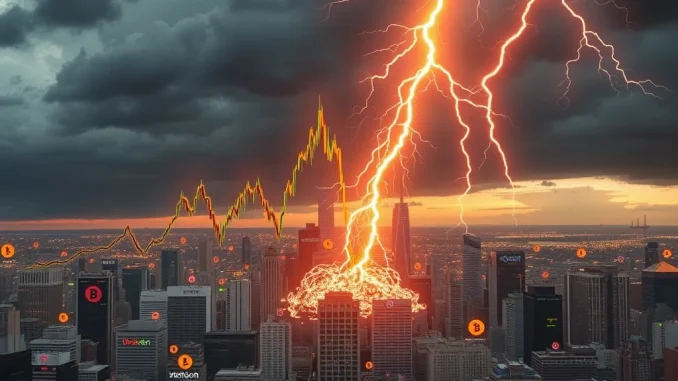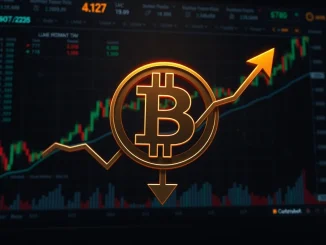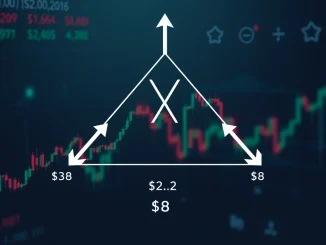
In a sudden jolt to the digital asset space, the cryptocurrency market witnessed a dramatic surge in crypto liquidations. A staggering $116 million worth of futures contracts were wiped out in just the past hour, highlighting the inherent crypto market volatility that continues to define the space. This recent cascade adds to the significant $368 million in futures liquidations recorded over the last 24 hours, leaving many traders caught off guard by the rapid price movements.
Understanding Futures Liquidations: What Just Happened?
So, what exactly are futures liquidations? In simple terms, they occur when a trader’s leveraged position is forcibly closed by an exchange. This happens because the trader has insufficient margin to cover potential losses as the price of the underlying asset (like Bitcoin or Ethereum) moves against their bet. Leverage trading allows traders to control a large position with a relatively small amount of capital, amplifying both potential profits and losses.
When the market moves sharply, as it appears to have done recently, positions with high leverage are particularly vulnerable. If the price crosses a certain threshold (the liquidation price), the exchange automatically closes the position to prevent the trader’s balance from falling below zero. This mechanism is designed to protect the exchange and other traders, but it can be devastating for the individual trader who loses their entire margin.
Here’s a quick breakdown:
- Leverage: Borrowing funds to increase trading position size.
- Margin: The trader’s own capital used as collateral.
- Liquidation Price: The price point at which the position is automatically closed.
- Liquidation: The forced closure of a leveraged position due to insufficient margin.
The Numbers Don’t Lie: $116 Million in an Hour
The fact that $116 million in bitcoin futures and other crypto futures were liquidated within a single hour is a clear indicator of extreme short-term price volatility. While $368 million over 24 hours is substantial, the concentration of over 30% of that amount in just one hour points to a very sharp, sudden price swing. This could have been triggered by a large order, a sudden news event, or a cascade effect where initial liquidations pushed the price further, triggering more liquidations.
Let’s look at the scale:
| Timeframe | Approximate Liquidation Value |
|---|---|
| Past 1 Hour | $116 Million |
| Past 24 Hours | $368 Million |
This concentration of losses in such a short period highlights the amplified risk associated with high leverage trading during volatile market conditions.
Why Did This Happen? Pinpointing the Triggers
While it’s often difficult to pinpoint a single cause immediately after such an event, several factors typically contribute to large-scale futures liquidations:
- Sudden Price Movement: The most direct cause is a rapid pump or dump in the price of major cryptocurrencies like Bitcoin or Ethereum. This move pushes leveraged positions past their liquidation points.
- Cascading Effect: When initial liquidations occur, the forced selling (or buying) from those closed positions can add further pressure to the price, triggering *more* liquidations in a domino effect.
- Market Sentiment Shifts: Unexpected news, macroeconomic data, or shifts in investor sentiment can lead to swift changes in market direction.
- High Leverage Use: A market environment where many traders are using high leverage magnifies the potential impact of even moderate price swings.
These events serve as a stark reminder that the crypto market volatility is not just a buzzword; it has tangible, significant consequences for traders.
The Impact on Traders and the Broader Market
For the traders involved, these crypto liquidations represent significant, often total, losses on their leveraged positions. This can be financially devastating, especially for those using high leverage with large position sizes.
For the broader market, mass liquidations can:
- Increase Volatility: The forced closure of positions adds to market pressure, potentially causing further price swings.
- Affect Sentiment: Large liquidation events can spook traders and investors, leading to increased caution or panic selling/buying.
- Reset Open Interest: Liquidations reduce the total number of open futures contracts, sometimes seen as a market ‘reset’.
While not necessarily indicative of a full-blown crypto market crash, events like this highlight underlying market conditions and risk levels.
Lessons from the Volatility: Navigating Leverage Trading
The recent wave of futures liquidations offers critical lessons, particularly for those engaging in leverage trading:
- Risk Management is Paramount: Never trade with more capital than you can afford to lose, especially when using leverage.
- Be Cautious with Leverage: Higher leverage increases risk exponentially. Consider lower leverage levels, particularly during periods of high uncertainty.
- Use Stop-Loss Orders: Setting stop-loss orders can help limit potential losses by automatically closing your position if the price moves against you by a specified amount, potentially *before* liquidation occurs.
- Understand Market Conditions: Be aware of the overall crypto market volatility and adjust your trading strategy accordingly. Avoid using high leverage just before major news events or during periods of low liquidity.
- Educate Yourself: Fully understand how bitcoin futures and other crypto derivatives work, including the mechanics of margin and liquidation.
Conclusion: A Stark Reminder of Crypto Market Risks
The $116 million in crypto liquidations in a single hour, part of a larger $368 million sweep over 24 hours, serves as a powerful and expensive reminder of the risks inherent in the cryptocurrency market, particularly when employing leverage. While leverage trading offers the potential for magnified gains, it also carries the significant risk of rapid and total loss through liquidation during periods of sharp crypto market volatility. As the market continues to mature, events like this underscore the critical importance of robust risk management, prudent use of leverage, and a deep understanding of the instruments being traded. Traders should approach futures markets with caution and respect for the speed at which fortunes can change.



